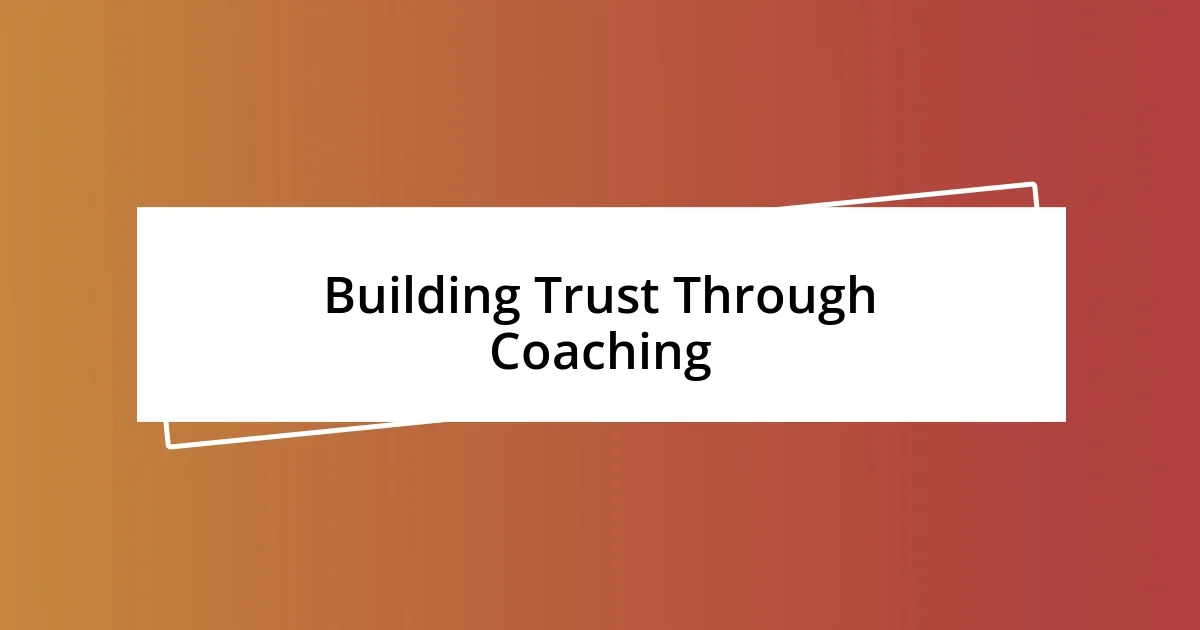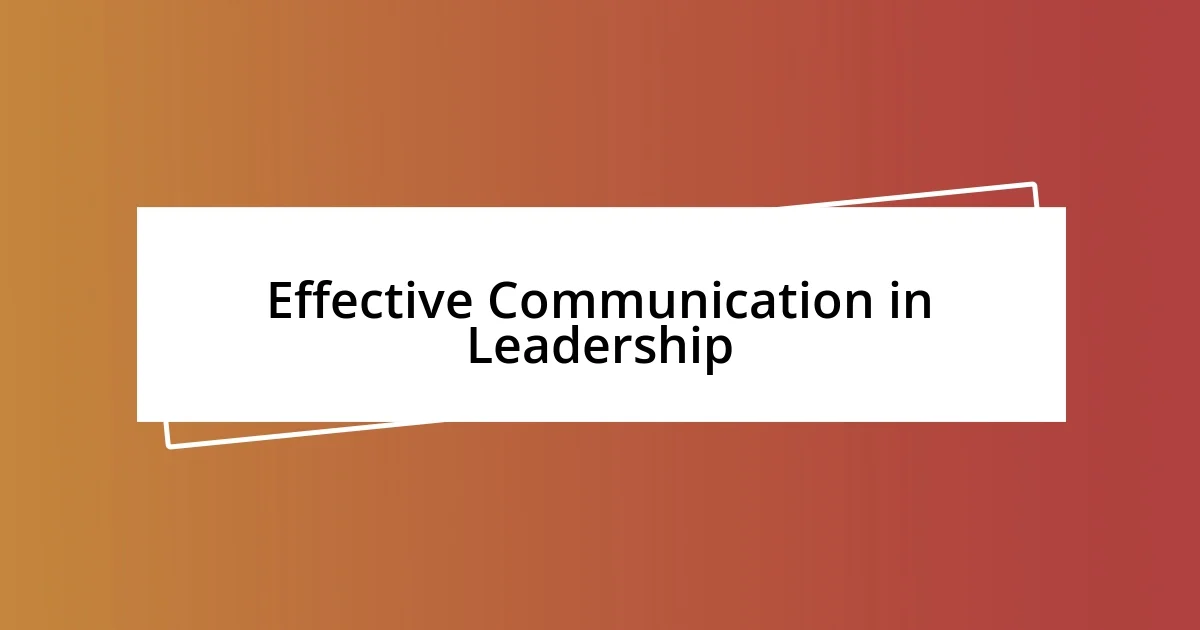Key takeaways:
- Coaching fosters self-awareness, emotional intelligence, and vulnerability, which are crucial for effective leadership and team dynamics.
- Building trust through open communication and consistent support enhances collaboration and innovation within teams.
- Applying coaching techniques such as active listening, setting clear goals, and reframing feedback promotes personal growth, accountability, and a culture of continuous learning.

Understanding the Role of Coaching
Coaching, in my experience, serves as a guiding light that illuminates paths we often overlook. I remember a time when a mentor asked me to identify my strengths and weaknesses in a group setting. That simple exercise sparked a profound self-awareness in me, showing just how pivotal coaching can be in shaping a leader’s perspective.
The role of a coach goes beyond mere instruction; it’s about cultivating a safe space for growth. Have you ever felt vulnerable when receiving feedback? I have. During a coaching session, I found myself sharing fears I hadn’t acknowledged before. The coach listened intently, validating my feelings, which ultimately empowered me to push through challenges with renewed confidence.
Through coaching, I learned that leaders aren’t just born; they’re developed. It made me reflect on how essential it is to foster relationships built on trust. If a leader can’t connect with their team on a personal level, how can they inspire them? This connection is where the real magic of coaching happens, transforming potential into performance and creating a harmonious team dynamic.

Key Lessons Learned from Coaching
Coaching has taught me that reflection is a powerful tool in leadership. I vividly recall a moment when I had to recount a challenging project during a coaching session. As I articulated my frustrations, I realized how valuable hindsight can be; it was like holding up a mirror to my decision-making process. This act of reflection not only helped me identify what went wrong but catalyzed a shift in my approach to future challenges.
Here are some key lessons I’ve gained from my coaching experiences:
- Emotional Intelligence is Essential: I learned that recognizing my emotions—and those of my team—can transform interactions into meaningful connections.
- Active Listening is Key: When I practiced truly listening, instead of just waiting for my turn to speak, the conversations became much richer and more productive.
- Vulnerability Builds Trust: Sharing my own missteps made team members more open to sharing theirs, fostering a culture of honesty and improvement.
- Setting Clear Goals: I found that establishing specific, measurable goals helped maintain focus and alignment within the team.
- Continuous Learning is Crucial: Coaching reinforced the idea that leadership is not a destination but a journey, and we’re all constantly evolving.
Each of these lessons has shaped my leadership style and reinforced the fundamental belief that authentic growth comes from both introspection and engagement with others.

Building Trust Through Coaching
Building trust through coaching is an intricate process that, in my experience, requires vulnerability and open communication. I recall a particular coaching session where I had to share a significant failure with my peers. The tension in the room was palpable, but as I opened up about my missteps and the lessons I learned, I could see the shift in dynamics. It wasn’t just me sharing; it was a collective experience. That moment highlighted how vulnerability lays the groundwork for trust to flourish.
I’ve also observed that coaching fosters an environment where team members feel safe to express their thoughts and ideas freely. During a group coaching exercise, I encouraged my colleagues to share their input on a project we were struggling with. To my surprise, the honest feedback that emerged was both eye-opening and constructive. This showed me how trust, when nurtured through honest coaching, can lead to innovative solutions that might otherwise remain unexplored.
Creating trust is not a one-time effort; it’s a continuous journey. One thing I’ve learned is that consistency is vital. In my coaching practice, I aim to follow up on commitments and build a rapport over time. Each small interaction contributes to a foundation of trust, making it easier for team members to rely on each other. When people know they can count on their leader to be there for them—whether through support, guidance, or simply being an active listener—trust becomes a powerful catalyst for team cohesion and success.
| Coaching Approach | Impact on Trust |
|---|---|
| Sharing Vulnerabilities | Encourages openness and authenticity among team members. |
| Soliciting Feedback | Creates an inclusive atmosphere where everyone feels valued. |
| Consistent Support | Builds reliability and reinforces a leader’s commitment to their team. |

Effective Communication in Leadership
Effective communication in leadership has been a game changer for me, especially when I learned to tailor my message to fit the audience. Early in my career, I assumed a one-size-fits-all approach, not realizing the disconnect that often resulted. It hit me during a team meeting; as I spoke, the blank stares told me everything. I knew I needed to adjust my communication style—a lesson that reinforced the idea that understanding your audience is crucial for meaningful dialogue.
I also discovered the power of body language in conveying intention and empathy. There was a time when I made a presentation while standing rigidly in front of the room. I could see how my closed-off stance unintentionally created barriers, instead of fostering an open exchange. Now, I consciously use eye contact and gestures to invite participation, making it easier to connect with my team. In those moments where I can feel the energy shift and engagement grow, I recognize that communication isn’t just verbal; it’s a dance between speaker and listener.
Moreover, I’ve come to appreciate the importance of clarity and conciseness. During a particularly complex project, I found that lengthy explanations led to confusion rather than understanding. It was a wake-up call when a team member asked me to clarify our objectives for the third time! By striving to communicate with clarity, I noticed a remarkable increase in my team’s confidence and output. Do you ever wonder how much more effective your leadership could be with just a few adjustments in communication? From my experience, the answer is quite compelling.

Fostering Team Collaboration
Fostering team collaboration is something I’ve come to recognize as essential in any successful endeavor. I remember a time when my team faced a particularly challenging deadline. Instead of pushing everyone to work individually, I gathered everyone for a brainstorming session. It was amazing to see how different perspectives came together, leading to innovative solutions none of us had considered alone. In that moment, I realized that collaboration sparks creativity and drives the whole team forward.
However, it’s not just about coming together during crunch time. I’ve learned that building a foundation for collaboration means actively creating spaces for team members to connect regularly. In one project, I implemented weekly check-ins where everyone shared updates and challenges. What I noticed was transformative. As the weeks progressed, team members began to collaborate even outside those meetings, willingly sharing resources and offering help. This organic growth of teamwork reinforced my belief that openness and structured opportunities for interaction lead to a tighter-knit, more resilient team.
But let’s be real: collaboration can be tricky. I once led a team with diverse personalities, which sometimes led to conflicts and misunderstandings. To navigate this, I started promoting empathy exercises—activities that encouraged team members to step into each other’s shoes. The change was palpable. Not only did the team start to communicate better, but they also developed a deeper appreciation for one another’s strengths. Have you ever wondered how a little empathy could transform dynamics in your own team? From my experience, it’s a game changer that can truly elevate collaboration to new heights.

Setting Goals and Accountability
Setting goals and holding myself accountable has been a transformative experience in my leadership journey. I remember creating a vision board for a large project; it served as a constant reminder of what we aimed to achieve. Having that visual representation not only inspired me but also allowed my team to see our combined goals clearly. How often do you find that a tangible reminder can boost motivation? I’ve learned that it’s these small but impactful tools that keep focus sharp.
Accountability takes on a new meaning when you’re leading a team. Early on, I made the mistake of assuming everyone was on the same page without explicitly defining our goals. This led to a project where deadlines were missed, and frustration mounted. Through that experience, I understood the significance of not just setting goals, but framing them within a shared commitment. By implementing regular progress check-ins, I saw a dramatic shift in my team’s enthusiasm. Have you ever felt the power of mutual accountability? It’s energizing to watch a team hold each other accountable and strive for success together.
In my experience, the emotional weight of accountability can strengthen relationships within a team. I recall a time when a team member struggled to meet their part of a project, feeling overwhelmed by external pressures. I chose to approach the situation with empathy rather than judgment. By being transparent about my own challenges and encouraging a collaborative problem-solving session, it fostered trust and unity. Have you thought about how vulnerability can enhance accountability? I’ve found that when leaders create an environment where it’s safe to be open, everyone wants to step up, knowing they have support.

Applying Coaching Techniques in Leadership
Applying coaching techniques to leadership can be a game-changer, particularly in building relationships and fostering trust. I vividly remember an instance where I employed active listening during a one-on-one with a team member. Instead of jumping to solutions, I simply listened as they expressed their concerns. That moment not only provided them with relief but also deepened my understanding of the challenges they faced, reminding me how critical it is to create a space where people feel heard. Have you ever considered how just listening can transform the dynamics of your team?
Coaching also emphasizes the importance of asking open-ended questions, which can empower team members to think critically. I was once in a situation where we were tackling a particularly complex issue, and I chose to ask, “What do you think our best course of action is?” I watched as engaged eyes lit up, with team members contributing ideas with confidence. This simple shift from a directive approach to an inquisitive one opened the floor to an array of creative solutions that I hadn’t even considered. How often do you find that your team has the answers but just needs the nudge to express them?
Moreover, providing constructive feedback through a coaching lens can alter how we perceive challenges. I recall delivering feedback during a performance review, focusing on growth rather than shortcomings. I framed it as an opportunity by saying, “Let’s explore how you can leverage your strengths for greater impact.” The transformation was evident; the team member left the conversation motivated and clear on the development path. Have you thought about how reframing feedback can shift the mindset from fear to growth? Personally, I’ve found that when leaders adopt a coaching mindset, they not only improve performance but also create a culture that embraces growth and continuous learning.














